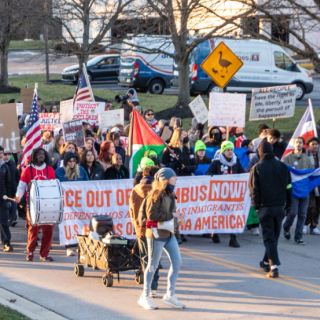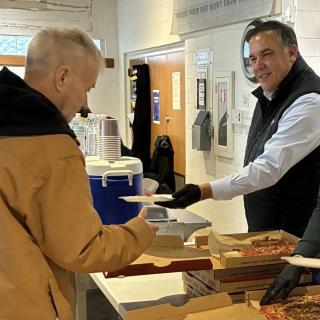Advertisement
When the activist and preservation group Community Improvement 614 wanted to know more about LinkUS plans for West Broad Street, a federal engineer spoke up, saying, “You won’t recognize West Broad when we’re done, it will look completely different.”
This was a Federal Transit Administration (FTA) engineer talking candidly, and also on that call with Community Improvement 614 were officials from the City of Columbus and COTA, the Central Ohio Transit Authority. Others heavily involved with LinkUS are the Columbus Partnership and MORPC {Mid-Ohio Regional Planning Commission), and construction on West Broad for LinkUS’s first “Bus Rapid Transit” (BRT) line is scheduled to begin in 2026 with its accordion buses running by 2028.
Community Improvement 614 hastily formed last summer after realizing LinkUS could drastically alter West Broad.
“We organized in a hurry because we needed to get going,” said Rebecca Hunley, a spokesperson for Community Improvement 614. “LinkUs was sold to Columbus voters as lollipops and rainbows without the effects on the environment or on historic structures for nine miles of West Broad Street.” Hunley is a Franklinton homeowner and also the current chair of the Franklinton Area Neighbors Civic Association, an organization she founded.
The LinkUS levy was approved by voters last year, and the 25-year, billion-dollars project will apparently revolutionize transit in car-centric Columbus. A hopeful example is the LinkUS plan for West Broad. This 9-mile “subway above ground” will stretch from downtown to Prairie Township with 17 stations, all built in the middle of West Broad Street.
West Broad of course is one of Columbus’s historical corridors, and no one is in denial this part of the “National Road” has given way to decline. Significant changes to West Broad near downtown and the casino have been in the works and taking on Columbus’s transit challenges have also become a priority. But per usual, the “Columbus Way” is forcing this massive undertaking down the throat of entire neighborhoods before anyone realizes what the heck is going on.
“Nobody knows what exactly they are going to do, and they gave us this map that was so big, and its one big red line from Galloway to downtown,” Hunley said.
Another member of Community Improvement 614, Marian Lupo, a former Harvard law professor who has a PhD in Administrative Law from Ohio State, initiated a letter writing effort (emails) to the FTA which has promised roughly $42 million towards the West Broad BRT line. After talking with an Ohio Department of Transportation (ODOT) historian, she was made aware the FTA must complete historical and environmental impact reviews of West Broad before construction.
What Lupo found was the FTA’s historical evaluations of West Broad – required by the National Historic Preservation Act of 1966 – had already been completed and only examined buildings on the corners where the 17 stations will be located. All this not taking into account how the entire project will affect West Broad. More perplexing is how the FTA historical evaluation determined the West Broad BRT line would have “No Adverse Effect.”
In response, Lupo wrote: “It is an ambitious project that appears to involve a widening of U.S. 40 and a possible impact on over eighty historic resources.” Later in this letter, she added, “When I speak to members of the public invested with an interest and expertise in the historic and cultural fabric…they are shocked to learn such a review [had] been underway.”
Lupo continued, “We have not been engaged at any stage of this process prior to the determination of ‘No Adverse Effect.’ This is in spite of our active outreach to the agency so that we may meaningfully engage in conversation early in the process.”
What’s more, the FTA, along with COTA and others, were required to conduct full public notice and meetings for the environmental impact review of West Broad. But the public was never notified, claims Community Improvement 614.
“The City of Columbus and COTA were all saying, ‘Oh no, we’re not widening the street, it won’t interfere. Oh no, nothing will be harmed or touched,’” says Hunley.
Lupo continued to pressure the FTA, COTA and other LinkUS representatives to meet with Community Improvement 614. But these LinkUS reps scoffed (apparently) at the preservationists and activists wanting to know more.
“In August 2024, we invited representatives from COTA and its LinkUS partners to a meeting to discuss the historical review. No one attended the meeting,” she wrote.
Finally, in November of 2024, officials from the FTA, COTA and others agreed to talk with Community Improvement 614. But this was after the fact. After the FTA had ruled “No Adverse Effect” for West Broad and when the FTA engineer stated, “You won’t recognize West Broad”.
Community Improvement 614 remains vigilant and will seek to protect historical buildings even if the FTA and others determined they were not historic by the standards of this project.
“What makes us nervous is they said they were not going to widen West Broad Street,” says Hunley. “But at the propose LinkUS station by West Broad Elementary they’re going to take out the tree, the sidewalk, and some of the front lawn. But they’re not widening West Broad?”
A station is also planned for Franklinton Square.
“My concern is a stop right there will overwhelm it with signs and plastic and chrome. Not exactly a historic setting,” she said.



